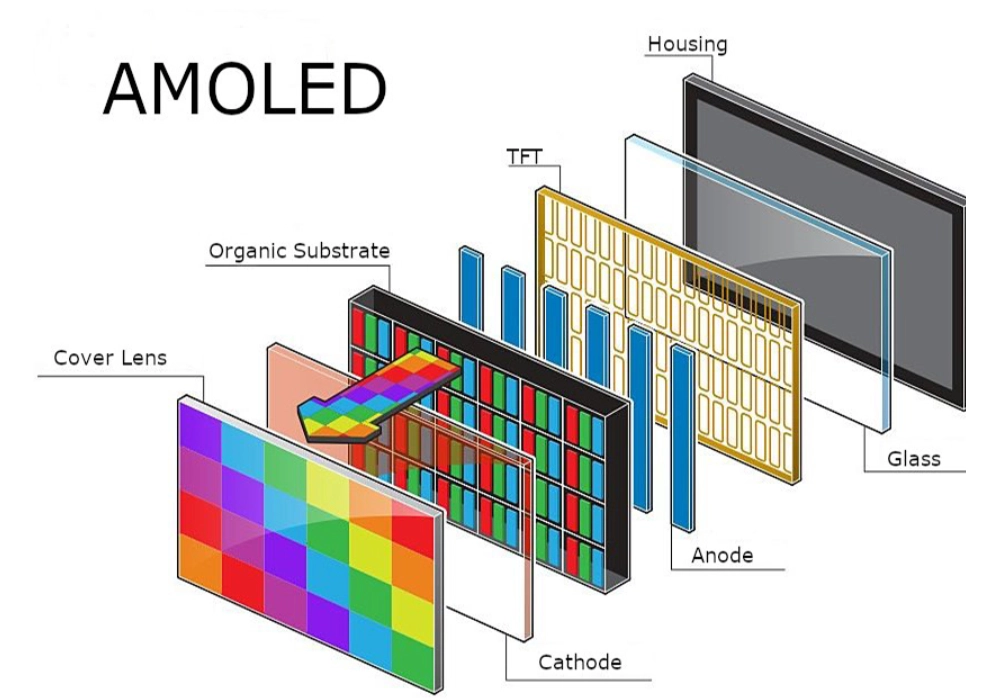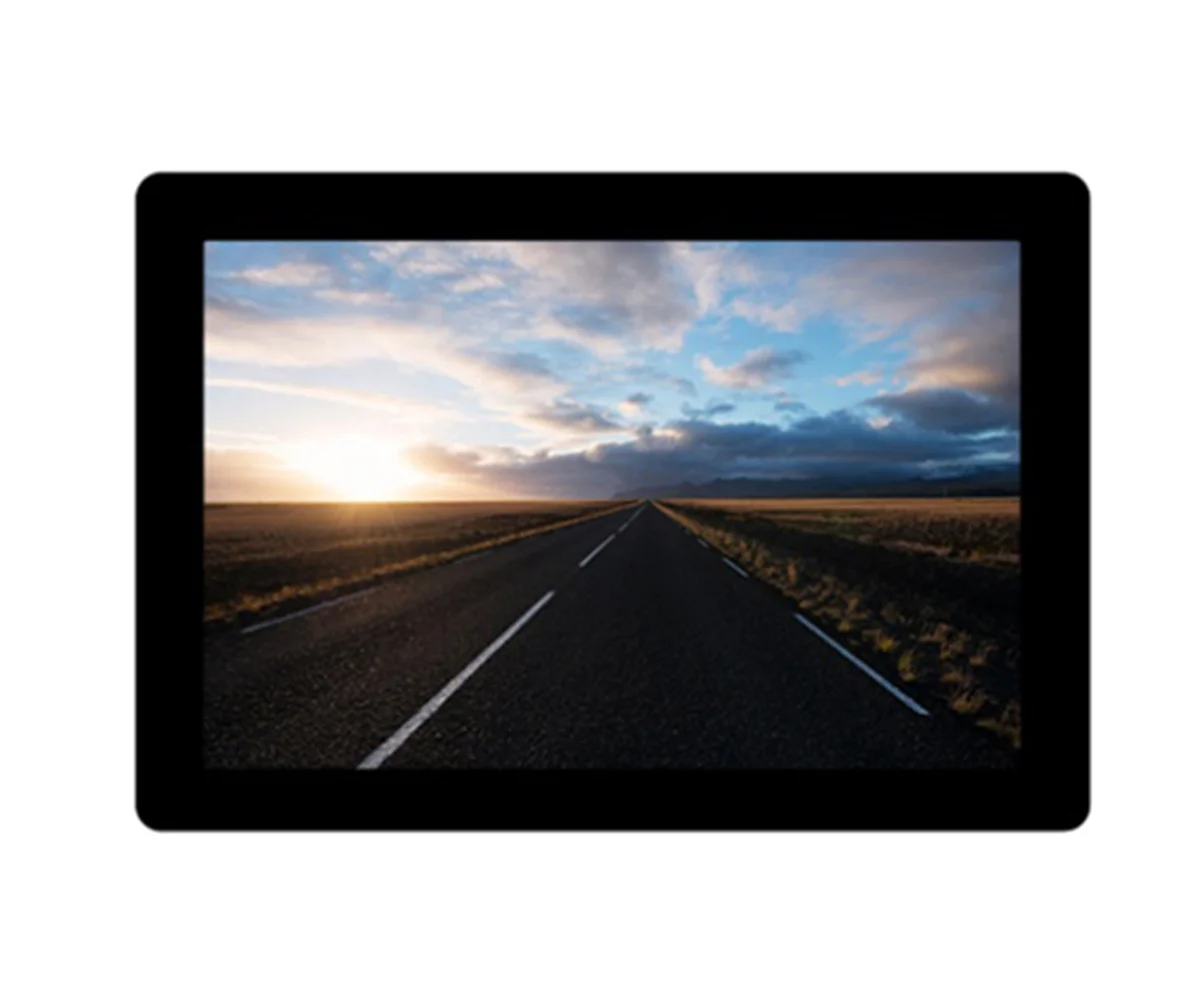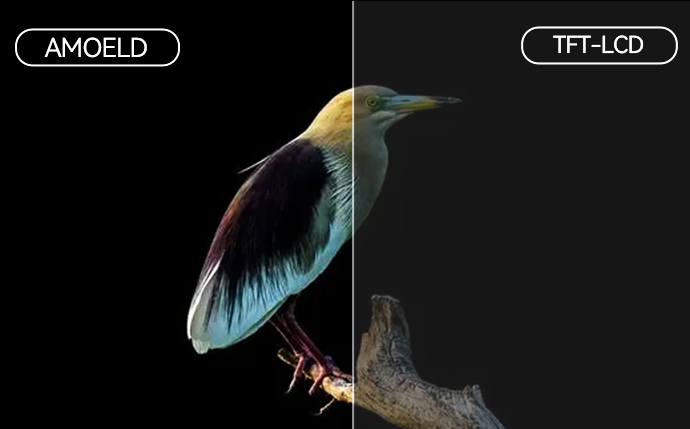AMOLED Displays: Understanding the Basics
Introduction to OLED Technology
OLED, or Organic Light Emitting Diode, is a screen tech. It uses organic stuff to make light when power is added. Unlike regular LEDs that use silicon, OLEDs use organic bits to glow. This setup skips the need for a backlight. So, OLED displays show true black shades and sharp contrast. Unlike TFT screens, which need a backlight and extra layers like diffusers, OLEDs shine on their own. This makes them simpler, thinner, and more power-saving.
Comparison with TFT Displays
TFT (Thin Film Transistor) screens need many layers. These include a backlight, color filters, and polarizers. But OLED tech skips these extras. Each pixel glows by itself. This makes OLED displays slimmer and lighter. They also show better pictures with clearer contrast and wider viewing angles. TFT screens use constant backlighting. This uses more power, especially for dark images, compared to OLEDs.
What Is An AMOLED Screen?
What Does AMOLED Mean
AMOLED means Active-Matrix Organic Light Emitting Diode. It builds on basic OLED tech. It adds an active matrix of thin-film transistors (TFTs). This lets it control each pixel exactly.

How AMOLED Works
AMOLED screens light up each pixel on their own. They don’t need a backlight. The active-matrix setup uses TFTs to control pixel brightness and color. When power flows through organic material between two electrodes (anode and cathode), light comes out. This makes screens thinner and saves energy.
Key Components of AMOLED Technology
Main parts of AMOLED screens include:
- Organic Materials: Thin layers of stuff likepolyfluorene glow when powered.
- Substrate: Glass or plastic supports the screen layers.
- Encapsulation: A shield protects organic bits from air and wetness.
- Thin-Film Transistors(TFTs): These manage power to pixels for clear images.
- Conductive Layers: Electrodes wrap organic layers to let power flow.
AMOLED vs OLED: Key Differences
The big difference between AMOLED and regular OLED is the matrix design. Normal OLEDs use a passive-matrix setup. But AMOLED has an active-matrix TFT layer. This boosts performance. AMOLED screens get higher resolutions, quicker refresh rates, and bigger sizes than passive-matrix OLEDs. Also, AMOLED’s active-matrix cuts problems like crosstalk or ghosting seen in simpler OLED designs.
Key Benefits of AMOLED Displays
Vibrant Colors and High Contrast Ratios
AMOLED displays are famous for bright colors and deep blacks. Each pixel makes its own light. It can turn off completely. This gives super high contrast ratios over 100,000:1. This makes images pop and easy to read in different light.
Enhanced Viewing Angles
AMOLED screens keep brightness and color steady even at wide angles, up to 160 degrees. This is great for groups. Everyone sees clear images from different spots.
Faster Refresh Rates for Improved Performance
AMOLED tech has refresh rates up to 120Hz or more. This makes videos, games, and animations smooth. Its quick response also supports touch rates up to 240Hz. This makes interactions super smooth.
Low Power Consumption in Dark Modes
AMOLED pixels only use power when they glow. This makes them super efficient for dark images or black backgrounds. Devices with dark modes save a lot of energy.
Thin and Lightweight Design Features
No backlight makes AMOLED displays super thin. Some are less than 1mm thick. Their light weight helps make sleek designs for many uses.
High Durability and Longevity
AMOLED panels are tough. They work in extreme heat or cold without backlight issues. Flexible types can handle bending. This makes them great for rough places.
Comparing AMOLED with Other Display Technologies
AMOLED vs Retina Displays
Retina screens aim for high pixel counts for sharp images. But AMOLED shines with bright colors, true blacks, and better contrast. This comes from its self-glowing pixels.
Differences Between AMOLED and LCDs
LCDs need constant backlighting. This limits true blacks and contrast. AMOLED’s self-glowing pixels give better colors, wider angles, faster responses, and save power on dark content.

Industrial Applications of AMOLED Displays
Human-Machine Interface (HMI) Displays in Industry
AMOLED HMIs show clear text and bright graphics. They work in bright conditions. They respond fast to touch. They use less power for always-on systems. They’re tough against factory wear.
Ruggedized Mobile Devices for Field Use
Field gadgets with AMOLED screens are easy to read in daylight. They’re flexible for tough designs. They save battery with efficient power use. They resist extreme weather.
Digital Signage and Retail Display Solutions
Stores use AMOLED’s vivid pictures for eye-catching product shows. Interactive signs stay clear in bright light.
Medical Display Innovations
In hospitals, AMOLED improves medical image clarity. It helps teamwork with wide angles. It supports light, portable gear designs.
Automotive Display Integration
New cars use AMOLED for dashboards and infotainment. They show sharp images in sunlight. They also power heads-up navigation aids.
Military-Grade Display Applications
Military uses include night vision goggles and foldable tactical gear. AMOLED panels give real-time updates in compact, wearable tech.
Marine Navigation Devices
Marine AMOLED panels work despite wetness. They stay clear in direct sunlight. This helps boats navigate tough waters.
Incorporation In Home Appliances
Modern appliances like fridges, ovens, and washers use AMOLED touchscreens. These give bright, easy-to-use interfaces.
Summary of AMOLED Applications Across Industries
AMOLED displays have changed many fields. They offer top visual quality, power savings, and design flexibility. Their uses are huge, from gadgets to special industry tools.
In smartphones and TVs, AMOLED tech gives bright colors and deep blacks. This boosts user fun.
In factories, AMOLED is used in Human-Machine Interface (HMI) displays. They show clear images in tough places.
Car dashboards use AMOLED for great sunlight readability and sharp pictures. Medical gear uses its precision for imaging and checks.
The military uses AMOLED for night vision gear and foldable tactical tools. Marine devices rely on its toughness and clear view in sunlight.
Home appliances like fridges and ovens now have AMOLED touchscreens. These look modern and work well.
Advancements in AMOLED Technology and Future Trends
MicroLED Displays as Emerging Competition
MicroLED tech is a new rival to AMOLED. It uses tiny LEDs as pixels. This gives brighter screens and more toughness. Hybrid displays mixing MicroLED and AMOLED could use both strengths.
Higher Resolution Capabilities
AMOLED panels support up to 4K now. Work is on for 8K. This is big for virtual reality (VR) and augmented reality (AR). High pixel counts make experiences super real.
Faster Refresh Rates for Enhanced User Experience
AMOLED refresh rates are hitting 240Hz. This makes motion clear for gaming, videos, and AR/VR. Fast responses also boost touch sensitivity for interactive systems.
Improved Energy Efficiency
New OLED materials aim to save more power. They cut energy use, especially for bright or white screens during long use.
Larger Screen Sizes for Broader Use Cases
New making methods allow bigger AMOLED panels. These fit TVs and digital signs. They keep the same great visuals as small screens.
Transparent and Flexible Display Innovations
Transparent and bendy AMOLED displays open new designs. Transparent screens fit store windows or car glass for AR uses. Flexible screens make foldable phones, rollable TVs, and cool industry designs.
Why Choose Kadi Display
Kadi Display leads in custom screen solutions. With over 20 years in the screen field, Kadi Display offers full services. They mix LCM/TP/PCBA parts into unique products. Their factory covers over 5,000 square meters. It has top standards with ISO9001/IATF16949 certifications.
Kadi Display makes LCM/TP/BONDING on its own. A skilled R&D team builds signal adapter boards, single-chip boards, and structural parts. Their custom services include changing cover glass designs (logo/color/thickness), backlight tweaks (brightness/thickness), pinout setups for LCM/CTP interfaces, and housing designs for easy assembly.
Using Shenzhen’s strong supply chain, Kadi Display delivers fast, tailored solutions. They keep quality high. Their focus on worker growth sparks new ideas. This ensures every product meets client hopes.
Frequently Asked Questions About AMOLED Displays
What is an AMOLED display?
AMOLED means Active Matrix Organic Light Emitting Diode. It uses organic stuff to glow from each pixel. No backlight is needed.
How does AMOLED differ from LCD?
Unlike LCDs that need constant backlighting, AMOLED pixels glow on their own. This gives true blacks and sharper contrast.
What are the main benefits of AMOLED displays?
Top perks include bright colors, wide viewing angles, quick refresh rates, low power use, slim light designs, and tough builds for rough places.










